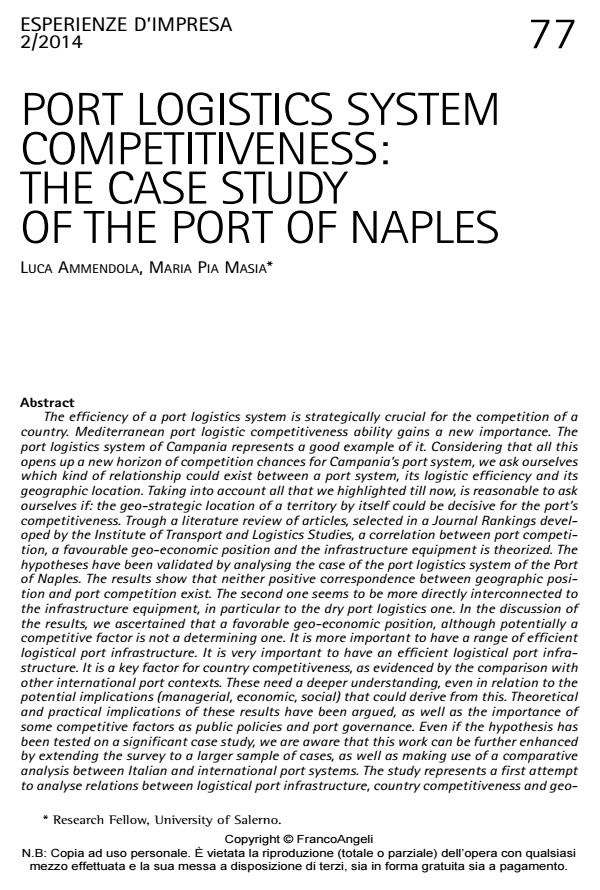Port logistics system competitiveness: the case study of the port of naples
Journal title ESPERIENZE D'IMPRESA
Author/s Luca Ammendola, Maria Pia Masia
Publishing Year 2015 Issue 2014/2
Language Italian Pages 19 P. 77-95 File size 191 KB
DOI 10.3280/EI2014-002005
DOI is like a bar code for intellectual property: to have more infomation
click here
Below, you can see the article first page
If you want to buy this article in PDF format, you can do it, following the instructions to buy download credits

FrancoAngeli is member of Publishers International Linking Association, Inc (PILA), a not-for-profit association which run the CrossRef service enabling links to and from online scholarly content.
The efficiency of a port logistics system is strategically crucial for the competition of a country. Mediterranean port logistic competitiveness ability gains a new importance. The port logistics system of Campania represents a good example of it. Considering that all this opens up a new horizon of competition chances for Campania’s port system, we ask ourselves which kind of relationship could exist between a port system, its logistic efficiency and its geographic location. Taking into account all that we highlighted till now, is reasonable to ask ourselves if: the geo-strategic location of a territory by itself could be decisive for the port’s competitiveness. Trough a literature review of articles, selected in a Journal Rankings developed by the Institute of Transport and Logistics Studies, a correlation between port competition, a favourable geo-economic position and the infrastructure equipment is theorized. The hypotheses have been validated by analysing the case of the port logistics system of the Port of Naples. The results show that neither positive correspondence between geographic position and port competition exist. The second one seems to be more directly interconnected to the infrastructure equipment, in particular to the dry port logistics one. In the discussion of the results, we ascertained that a favorable geo-economic position, although potentially a competitive factor is not a determining one. It is more important to have a range of efficient logistical port infrastructure. It is very important to have an efficient logistical port infrastructure. It is a key factor for country competitiveness, as evidenced by the comparison with other international port contexts. These need a deeper understanding, even in relation to the potential implications (managerial, economic, social) that could derive from this. Theoretical and practical implications of these results have been argued, as well as the importance of some competitive factors as public policies and port governance. Even if the hypothesis has been tested on a significant case study, we are aware that this work can be further enhanced by extending the survey to a larger sample of cases, as well as making use of a comparative analysis between Italian and international port systems. The study represents a first attempt to analyse relations between logistical port infrastructure, country competitiveness and geographic position. In conclusion, it would be interesting to consider even port governance among the competitive factors, as it uses public and private financial resources and often decides on their final use.
Keywords: Port logistics, Intermodal logistics and integrated logistics, Dry port system.
Luca Ammendola, Maria Pia Masia, Port logistics system competitiveness: the case study of the port of naples in "ESPERIENZE D'IMPRESA" 2/2014, pp 77-95, DOI: 10.3280/EI2014-002005